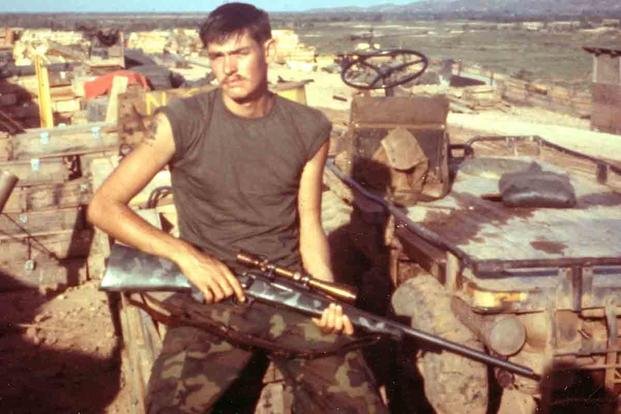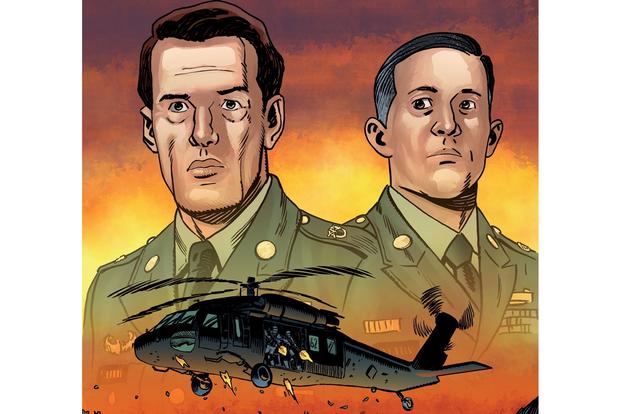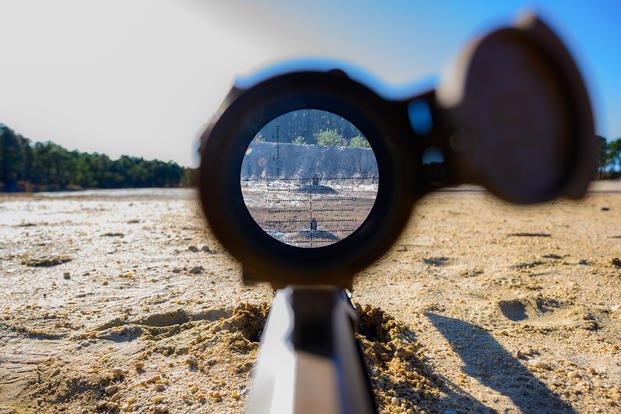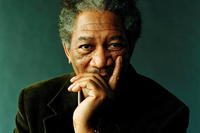The most notable snipers in U.S. military history aren’t just legends – they include real soldiers, sailors and Marines who stood their ground with extraordinary courage.
From battlefield snipers to record-setting, long-distance shooters, from war heroes turned public figures, these marksmen left a mark.
US Marine Gunnery Sgt. Carlos Norman Hathcock II
- Hometown: Little Rock, Arkansas
- Nickname: "White Feather"
- Years of service: 1959-1979
- Wars: Vietnam War, two tours
- Confirmed kills: 93 (unconfirmed believed to be much higher)
One of the most legendary combat heroes was USMC Gunnery Sgt. Carlos Norman Hathcock II. His fame grew from countless acts of bravery on the battlefield. He was an incredible woodsman with unmatched patience, traits that served him well in the jungles of Vietnam, where he served two tours.

Among Hathcock’s impressive stories of wartime success was a manhunt that required him to cross enemy lines to dispatch a North Vietnamese Army general. He went four days without food, water or sleep, crawling inch by inch on his side, to get safely within range of the general. At 700 yards, he took out the target and retreated to safety.
His longest confirmed kill was at 2,500 yards (about 2,286 meters), one of the longest recorded sniper kills of the Vietnam War. It was later surpassed by Canadian shooters Master Cpl. Arron Perry (2,310 meters) and Cpl. Rob Furlong (2,430 meters) in Afghanistan in 2002.
Hathcock stated his motivation as a sniper was to do his duty and protect his fellow Marines.
Life After Service
Hathcock was diagnosed with multiple sclerosis in 1975 and had to medically retire four years later, just a couple of months shy of a 20-year service.
After leaving the Marines, the married Virginia Beach resident fell into a depression and couldn't find work. Eventually, he used a wheelchair to get around.
He bristled at being called a "living legend," rarely told war stories and almost never used weapons again, even turning in his hunting license.
"It used to be fun," he told the Chicago Tribune in 1986. "It just wasn't fun anymore."
However, he volunteered in the 1980s as a sniper trainer for the Norfolk, Virginia, police department's SWAT team and local FBI.
He died in 1999 at age 57 from complications of MS. "His death came two weeks after he helped pin a promotion on his only child, 34-year-old Gunnery Sgt. Carlos Hathcock III," according to his obituary in the Los Angeles Times.
Read More: This Marine Was the 'American Sniper' of the Vietnam War
US Army Scout William Dixon
- Hometown: Ohio County, Virginia (now West Virginia)
- Nickname: "Billy"
- Years of service: Roughly 1874-1883 (at times as a civilian scout)
- Wars: Battle of Adobe Walls, Battle of Buffalo Wall
U.S. Army Scout William “Billy” Dixon was a marksman famed for one of the longest kill shots in combat, at 1,538 yards. Dixon was an American buffalo hunter and scout in the Texas Panhandle in the 1800s. He learned how to hunt game out of necessity as a young boy, which helped him grow into an exceptional marksman. Dixon is one of only eight civilians ever to receive the Medal of Honor.
Before joining the U.S. Army Scouts, Dixon led founders of Adobe Walls to the Texas Plains in 1874. Twenty-eight men and women from the group were attacked by an estimated 1,000 Native Americans. Dixon demoralized the Native warriors by making his 1,538-yard kill shot, which he admitted was a lucky shot. “The Shot of the Century” spooked the assailants, causing them to retreat – although the battle had already turned in favor of the defenders due to superior weaponry.
Life After Service
Dixon lived in the Adobe Walls area of Hutchinson County, Texas, where his seven children were born. His wife was a former schoolteacher from Virginia.
He and his family later moved to an Oklahoma ranch, where he died in 1913. He was working on an autobiography at the time, which his widow took over after his death.
US Army Ranger Sgt. Nicholas Irving

- Unit: 3rd Ranger Battalion, U.S. Army
- Hometown: Fort Meade, Maryland
- Nickname: "The Reaper"
- Years of service: 2004-2010
- Wars: Three tours in Iraq, one tour in Afghanistan
- Confirmed kills: 33 in less than four months
Irving was the first Black sniper in the 3rd Ranger Battalion. “He’d initially hoped to join the Navy SEALs, but wound up serving with the Army after failing a colorblindness test,” according to War History Online.
He named Carlos Hathcock as his lifelong idol. During his final tour in Afghanistan, it is estimated that he killed 33 insurgents in less than four months. Other Rangers nicknamed him “The Reaper” because of his fierce effectiveness.
"Irving had hot hands," is how a New York Daily News article described him in 2015.
Life After Service
After leaving the Army in 2010, Irving “burned up his savings feeding an alcohol habit that could’ve easily driven him into homelessness had he not stumbled upon a self-publishing website,” Adam Linehan reported for Task & Purpose.
He began writing “The Reaper,” his first book, which earned him a deal with a big publishing house, and a spot on Fox’s reality television series “American Grit.”
It would be the first of several books he wrote about his experience in combat. A later one, “Way of the Reaper: My Greatest Untold Missions and the Art of Being a Sniper,” has a slightly misleading title because it also “illustrates the human side of war: fear, anxiety, pain, embarrassment, elation, relief, and guilt,” according to a review by retired U.S. Navy Capt. James F. Buckley.
Irving has been publicly critical of the term "sniper" being used too loosely to describe shooters.
Read More: Ex-Army Ranger Nicholas Irving on Becoming ‘The Reaper’
US Army Staff Sgt. Adelbert ‘Bert’ F. Waldron
- Unit: 9th Infantry Division, 3rd Battalion, 60th Infantry Regiment (also attached to 3rd Brigade, 9th Infantry Division)
- Hometown: Born in Virginia, raised in upstate New York
- Nickname: Code name "Daniel Boone" in Vietnam
- Years of service: 1953-1970; 1968-1969 Vietnam combat service (previously U.S. Navy, then Army)
- Wars: Vietnam War
- Confirmed kills: 109
The son of a truck driver, Adelbert “Bert” Waldron graduated from Syracuse University in New York. He served in the Navy in the 1950s and 60s, before enlisting in the Army in 1968 and was shipped to the Mekong Delta that same year. It was there that he achieved 109 confirmed kills.
Until 2011, he held the highest officially confirmed U.S. sniper tally during Vietnam.
On multiple occasions, Waldron exposed himself to enemy fire to protect his unit. His marksmanship was legendary. In one famous account, during a river patrol, he spotted a Viet Cong fighter hidden in a palm tree. Despite the rocking motion of the vessel, he dropped the target with a single shot at nearly 900 yards.
In the Mekong Delta, he broke up ambushes by calmly eliminating concealed enemy fighters before they could strike. On several night missions, he deliberately shifted positions under fire, creating the illusion of a much larger U.S. force and forcing enemy troops to withdraw.
Life After Service
Waldron served as an instructor at the Marksmanship Training Unit at Fort Benning in Georgia before being discharged in March 1970. He then stepped into a role as a civilian law enforcement counter-sniper expert. The concept was just emerging as a law enforcement tool in the United States.
Waldron, who was married at least four times, lived a mostly quiet civilian life after his service. In contrast to some other snipers, he avoided the spotlight.
However, he was one of the few two-time recipients of the Army’s Distinguished Service Cross, both awarded for separate actions in 1969. Even earning the Distinguished Service Cross once is unusual.
Later in life, he moved to Southern California, where he lived steps from the ocean between Los Angeles and San Diego. He died in Riverside, California, in 1995 at age 62.
US Navy SEAL Chief Petty Officer Chris Kyle

- Unit: SEAL Team 3
- Hometown: Grew up on a ranch in Odessa, Texas
- Nicknames: “American Sniper” and “The Devil of Ramadi” (nickname given by Iraqi insurgents)
- Years of service: 1999-2009
- Wars: Iraq War (four combat deployments)
- Confirmed kills: 160 in Iraq (highest in U.S. military history)
Like many top snipers, Chris Kyle began hunting in childhood. From boyhood, he told The Dallas Morning News, "I only had two dreams. One was to be a cowboy and the other was to be in the military."
He joined the Navy SEALs in 1999 and served four combat deployments to Iraq.
He earned a reputation for protecting U.S. Marines and soldiers during urban combat in Ramadi and Fallujah. His first kill in Iraq was a female suicide bomber who was approaching a group of Marines. Another time, he killed an insurgent from about 2,100 yards to prevent a grenade attack on an Army convoy.
Overall, his overwatch positions saved countless U.S. lives, and his precision fire became legendary.
The author of "American Sniper: the Autobiography of the Most Lethal Sniper in U.S. Military History," he was known as much for his steady nerve and patience as he was for his marksmanship.
Life After Service
Kyle retired in 2009, later explaining that he left the military to save his marriage. He launched a security firm based in Dallas and co-founded a nonprofit that helped wounded veterans become physically fit.
He worked the celebrity circuit because "I wanted to get it out about the sacrifices military families have to make," he once said.
In 2013, at age 38, Kyle was fatally shot by a veteran during a charity event at a shooting range in Texas.
US Marine Corps Lance Cpl. Charles Benjamin Mawhinney

- Unit: 1st Battalion, 5th Marines, 1st Marine Division
- Hometown: Lakeview, Oregon
- Nickname: Chuck
- Years of service: 1967-1970
- Wars: Vietnam
- Confirmed kills: 103 in Vietnam (with 216 more probables)
A troubled youth, Chuck Mawhinney joined the Marine Corps and trained to become a scout sniper at Camp Pendleton in California. He was sent to Vietnam while still a teenager.
He was renowned for consistency and precision, able to make difficult shots in rapid succession. His peers considered him an exceptionally disciplined sniper. One of his most famed moments came on Valentine's Day 1969, when he caught a North Vietnamese platoon crossing an open stream. He killed 16 of them with 16 head shots.
He was the deadliest sniper in Marine Corps history.
Life After Service
Mawhinney left the Marine Corps in 1970 and joined the U.S. Forest Service in his southern Oregon hometown until he retired in the 1990s. After retirement, he volunteered to train law enforcement, SWAT and military teams. He and his wife Robin also ran a catering business.
He kept his time as a sniper secret for decades after the war ended. Even his closest friends didn’t know he was a Vietnam War legend. It wasn’t until the 1990s that his record was fully brought to light. And that was only because of a book written by fellow Marine sniper Joseph Ward, "Dear Mom: A Sniper's Vietnam.”
He died in March 2024 in Baker City, Oregon, at age 74, leaving behind his wife, Robin, and three children.
US Army Delta Force Master Sgt. Gary Gordon and Sgt. 1st Class Randy Shughart

- Unit: 1st Special Forces Operational Detachment-Delta (Delta Force)
- Hometowns:
- Gordon: Lincoln, Maine
- Shughart: Lincoln, Nebraska (later grew up in Newville, Pennsylvania)
- Years of service:
- Gordon: 1978-1993
- Shughart: 1976-1993
- War: Somali Civil War (Operation Gothic Serpent, 1993)
- Confirmed kills: Not publicly documented
Gary Gordon and Randy Shughart, two of the most legendary U.S. snipers/operators, are remembered more for their sacrifice than for confirmed kills. Gordon and Shughart were both Delta snipers who held off overwhelming Somali forces during the 1993 Battle of Mogadishu, sacrificing their lives to protect downed pilots. A total of 18 U.S. soldiers were killed.
A thrill-seeker who enjoyed hunting as a young boy, Shughart joined the Army after high school because he wanted to improve his weapons and survival skills. His goal at one point was to become a hunting guide, but he later grew so dedicated to military service that he asked his wife to promise never to ask him to stop being a soldier.
Gordon – the son of a Marine Corps veteran who'd served in Korea – joined the Army just out of high school and trained as a combat engineer before becoming a special forces engineer two years later. He completed French Mountain School and Ranger School, and later joined the 1st Special Forces Operational Detachment-Delta at Fort Bragg, North Carolina. He advanced steadily during his Army career.
Together in Mogadishu, their heroism during the 16-hour battle was recounted in the book and movie “Black Hawk Down.” They posthumously earned the Medal of Honor.
On that fateful day, Gordon and Shughart saw a Black Hawk helicopter go down behind enemy lines. Hundreds of armed fighters were closing in on the crash site, and there were only a handful of wounded U.S. soldiers left alive inside. Knowing that no reinforcements would make it in time, they volunteered – three times – to be dropped in to protect the crew. When they finally got permission, they fought their way through the shanties with just their rifles and pistols, pulling the injured men from the wreckage and setting up a tiny perimeter.
The comrades held off attackers as long as possible, taking out fighters one by one. They kept fighting until they were killed. Gordon was 33 and Shughart 35.
Author's note: The snipers highlighted here were chosen because their names and records became part of the public story — confirmed kills, citations, or lives lived in the spotlight after service. But that doesn’t mean their stories are the only ones worth remembering. For every name in print, there are thousands of men and women whose sacrifices will never be tallied, whose heroism lives in the love and respect of those closest to them.
– Blake Stillwell and Chelsea K. Tucker contributed to this report.
Want to Know More About the Military?
Be sure to get the latest news about the U.S. military, as well as critical info about how to join and all the benefits of service. Subscribe to Military.com and receive customized updates delivered straight to your inbox.















